Intel Core i7 4960X (Ivy Bridge E) Review
by Anand Lal Shimpi on September 3, 2013 4:10 AM EST- Posted in
- CPUs
- Intel
- Ivy Bridge
- Ivy Bridge-E
Memory Performance
Seeing as how the huge L3 cache and quad-channel memory interface are big parts of what makes Ivy Bridge E unique, I thought it might make sense to look at memory latency and bandwidth. We'll start with memory latency, compared to Ivy Bridge, Haswell and Haswell + Crystalwell.
The larger L3 cache buys IVB-E lower latency accesses for a wider range of addresses, but once you exceed the 15MB L3 cache space we see latency about on par with everything else. Only Haswell + Crystalwell manages to hold out for longer. Unfortunately that's not really a part desktop enthusiasts can buy so it's mostly an academic comparison.
The bandwidth story is an interesting one. Sandra maxes out bandwidth by driving all cores at the same time, so you get some uplift here by there simply being more cores under IVB-E's hood. But even if you divide out the number of cores, you get per core cache bandwidth figures that are extremely high (at least outside of L1). The L3 cache in particular is quite bandwidth happy.
Going outside of the L3 cache, we also see a doubling of memory bandwidth - which is expected given the doubling of memory interface width. In reality the peak memory bandwidth advantage would be even larger as IVB-E officially supports DDR3-1866 (if you only populate 1 DIMM per channel, otherwise either 1333 or 1600 is officially supported).
General Performance
I don't know that I've ever seen an Intel slide before that called out a performance degradation, but there's a first time for everything:
The problem with IVB-E vs. Haswell is that the extra large L3 cache and quad-channel memory interface are generally only useful in heavily threaded applications, which of course benefit from its 6-core configuration. In those tests that aren't heavily threaded however, IVB-E typically sees a single threaded performance deficit compared to Haswell. Given that the 4960X and Haswell based Core i7-4770K run at very similar frequencies, it's not surprising to see IVB-E take a backseat to Haswell in in "everyday computing" tasks. Intel's slide above claims about a 18% reduction in "everyday computing" performance compared to the 4770K, but in practice I found the gap to be much narrower.
Although not the best indication of overall system performance, the SYSMark 2012 suite does give us a good idea of lighter workloads than we're used to testing.
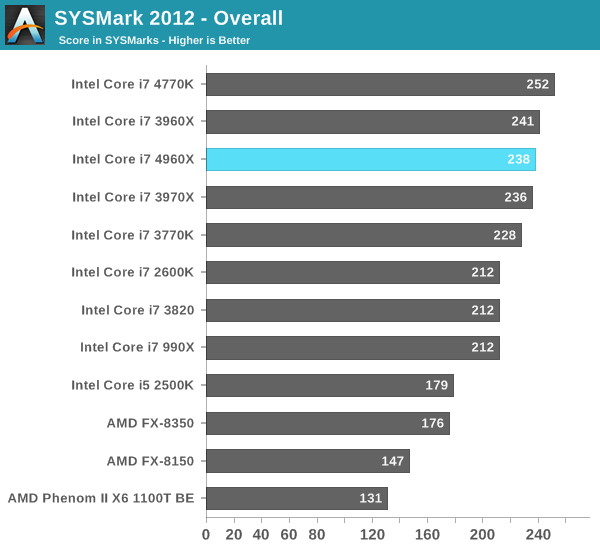
There's pretty much no advantage to the 4960X over the 3970X here. Remember Ivy Bridge's architectural improvements were very limited on the CPU side. As clock speeds didn't really go up between the 3970X and 4960X, the performance parity here isn't surprising. Haswell manages a ~6% performance advantage over the 4960X at an obviously lower power and price point.
Although I retired SYSMark 2007 a while ago, I do have much older performance data here which lets us compare the 4960X back as far as the early Pentium 4 based Extreme Edition parts:
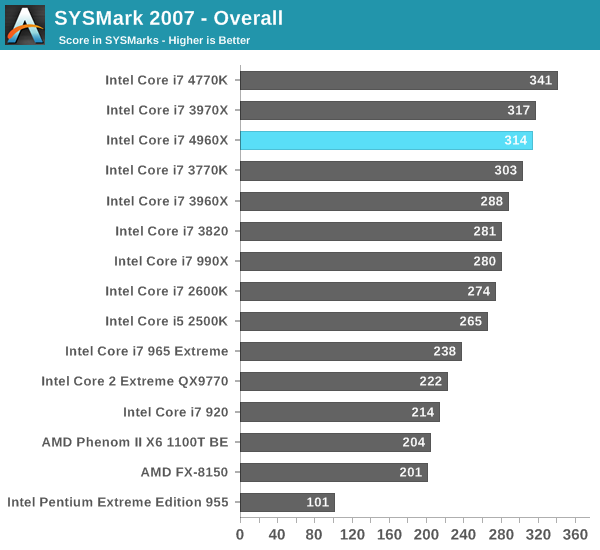
The Haswell advantage grows a bit here to around 8%, but the 4960X remains in the top three performers here. It's very clear that for most users, there are far more cost effective ways of getting great performance than IVB-E.
Our final lightly threaded test is Mozilla's Kraken JavaScript benchmark. This test includes some forward looking js code designed to showcase performance of future rich web applications on today's software and hardware. We run the test under IE10:
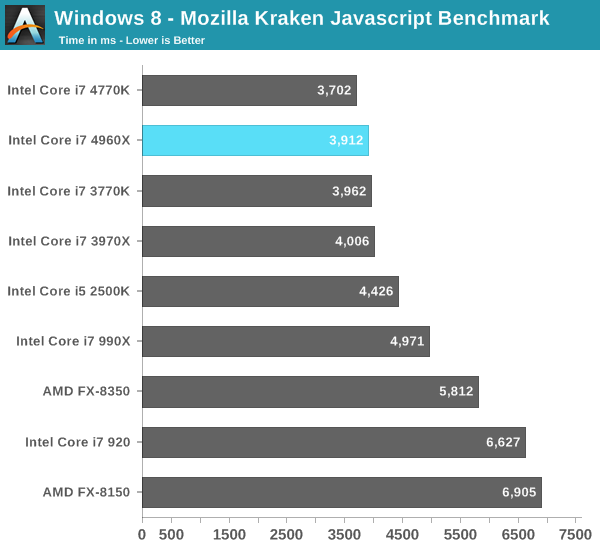
Ivy Bridge always had good single threaded performance, but once again these lightly threaded use cases are better served by an architecture with higher IPC. The Haswell advantage isn't huge, but it's a lower power/more cost effective way to get the best performance here.
If you are still on LGA-1366, you'll note that the performance gains here are good, but not earth shattering. Comparing to Intel's first 6-core platform, the 4960X manages a 27% increase in performance over the Core i7-990X. That's a healthy gain, but it's still small enough where there's no immediate need to upgrade.


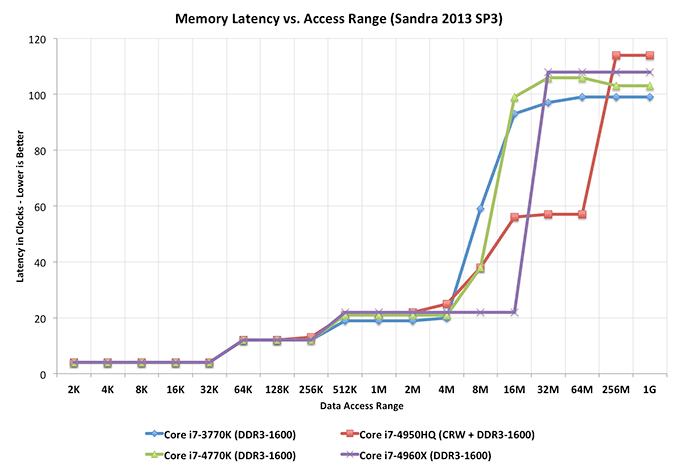
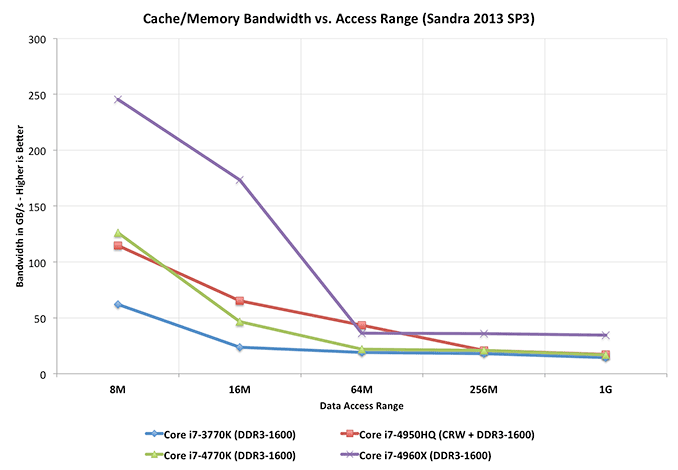
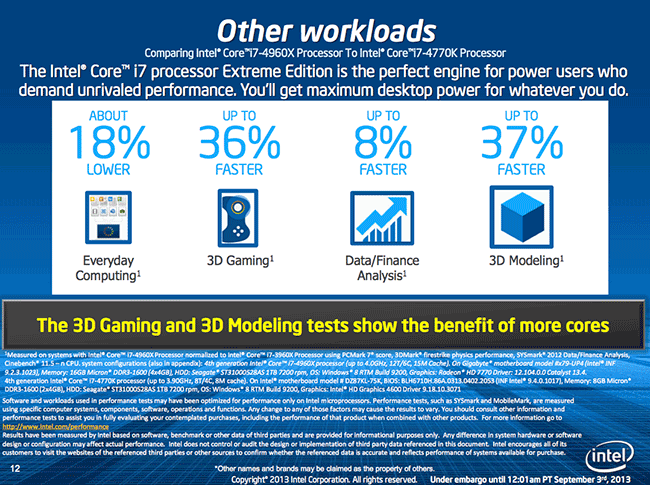








120 Comments
View All Comments
randfee - Tuesday, September 3, 2013 - link
anyways, I am likely to wait for Haswell XEONs next year, with AVX2 (which greatly enhances such scientific calculations if used) and DDR4 ;)noeldillabough - Thursday, September 5, 2013 - link
dual Xeons, I have a supermicro 2U unit with low voltage xeons (they were $650ish each) and they're great. You can pick and choose board to have as much ECC memory as you want!wallysb01 - Tuesday, September 3, 2013 - link
The E5-1660 will be the same as the 4960X, just not unlocked and with ECC. Same 6 cores, same 3.6-4.0 GHz range. Is the overclocking really worth all the hassle for maybe 20% speed increase, even if you had ECC?But I generally agree, it looks like Ivy Bridge 49xx/E5-16xx v2 is probably worth skipping. The upgrade over Sandy is not that much, and Haswell will likely bring 8-cores to the 59xx/16xx v3 space. Ivy Bridge for the top end only really made big gains in the 26xx space thanks to adding 10 and 12 core options, but man do you pay for them....
mapesdhs - Wednesday, September 4, 2013 - link
You sound like the kind of person who'd benefit from a used SGI UV 10 or UV 100.
No idea about their availability though.
Ian.
mapesdhs - Wednesday, September 4, 2013 - link
Oops, I was replying to randfee btw. Apologies for any confusion.Ian.
FwFred - Wednesday, September 4, 2013 - link
Intel offers plenty of parts for you. See the Xeon line--it doesn't need to be high end.JlHADJOE - Tuesday, September 3, 2013 - link
Intel Marketing: Honest guys.Michael REMY - Wednesday, September 4, 2013 - link
VERY VERY congratulation to Anandtech for having put in the test the old flagships cpu ! Now we can really compare and read more & more deeper the evolution and interest in this architecture.It is great that someone underdstood people do not buy or change each year their whole computer, but only every 3-4 year .
Very Thank you my Lord Anandtech
Remarius - Wednesday, September 4, 2013 - link
Would be fascinated to see some statistics re tri and quad sli usage as I'm already using 3 titans. There seems to be almost no coverage at that end of the scale despite being one of the target markets for this chip.noeldillabough - Thursday, September 5, 2013 - link
Heh I'd be happy with ONE Titan :) But I'd love to see those results too!